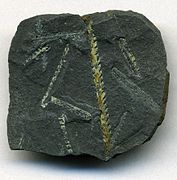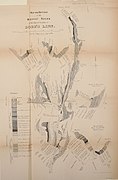Dob's Linn
| Dob's Linn | |
|---|---|
 Looking down Dob's Linn Gorge from the top | |
| Floor elevation | 300 m (980 ft) |
| Geography | |
| Country | Scotland |
| District | Dumfries and Galloway |
| Coordinates | 55°25′47″N 3°16′11″W / 55.4297°N 3.2697°W |
Dob's Linn is a small steep valley in
Dob's Linn is important in geology as the location of the
The boundary is defined as the
The area was first studied by Charles Lapworth in the late 19th century. His work established fossil graptolites as a method of understanding stratigraphic sequences.[6] A more recent description of the area, enumerating the zones established by Lapworth, is given in the British Regional Geology Monograph.[7] Before Lapworth's work, it was thought that the Silurian rocks of the Southern Uplands formed a single sequence, that would have to be about 6000m in thickness. By his identification of particular graptolite species in different zones of the Dob's Linn exposure, Lapworth was able to demonstrate that the Uplands consist of a much thinner layer, consistent with Silurian deposits elsewhere, that had been repeatedly folded and faulted, with multiple repetitions of the same strata, often upside down.[8] The understanding that sequences of sedimentary rocks could be inverted played an important part in the later resolution of the Highlands Controversy in which Lapworth was also involved.
References
- ^ National Trust for Scotland: Grey Mare's Tail Nature Reserve
- ^ Hogg, James (1869). Thomson, Thomas (ed.). The works of the Ettrick shepherd. London: Blackie and Son. p. 77.
- ^ Ogg, James. "GSSP for the Ordovician-Silurian Boundary". Archived from the original on 18 June 2006. Retrieved 1 July 2006.
- ^ "Dob's Linn". Scottish Geology. Hunterian Museum. Archived from the original on 18 May 2011. Retrieved 1 July 2006.
- .
- .
- ^ Pringle, J. (1948). British regional Geology: The South of Scotland (2 ed.). London: Her Majesty's Stationery Office (HMSO). pp. 34–46.
- ISBN 978-0-226-62635-2.
External links
- Clarkson, E.N.K.; Taylor, C.M. (1992). "Dob's Linn, Moffat - an excursion". from: Scottish Borders geology: an excursion guide. Scottish Academic Press. Retrieved 28 January 2019.
Gallery
-
Folds in the Rock Strata high up in the Dob's Linn Gorge
-
Plan of the typical locality of Dobb's Linn (sic) (after Lapworth)
-
Climacograptus wilsoni graptolite fossils on black shale (26 x 25 millimetres) of middle Ordovician age (Soudleyan Stage, ~mid-Caradocian) from the main cliff at Dob's Linn (about 36.1-43.1 metres below the Ordovician-Silurian boundary GSSP
-
Lapworth's original map of the exposure at Dob's Linn
55°25′47″N 3°16′11″W / 55.42972°N 3.26972°W





